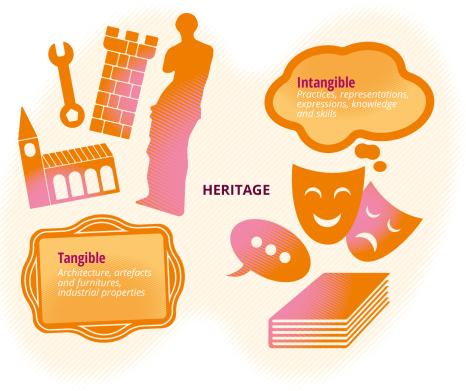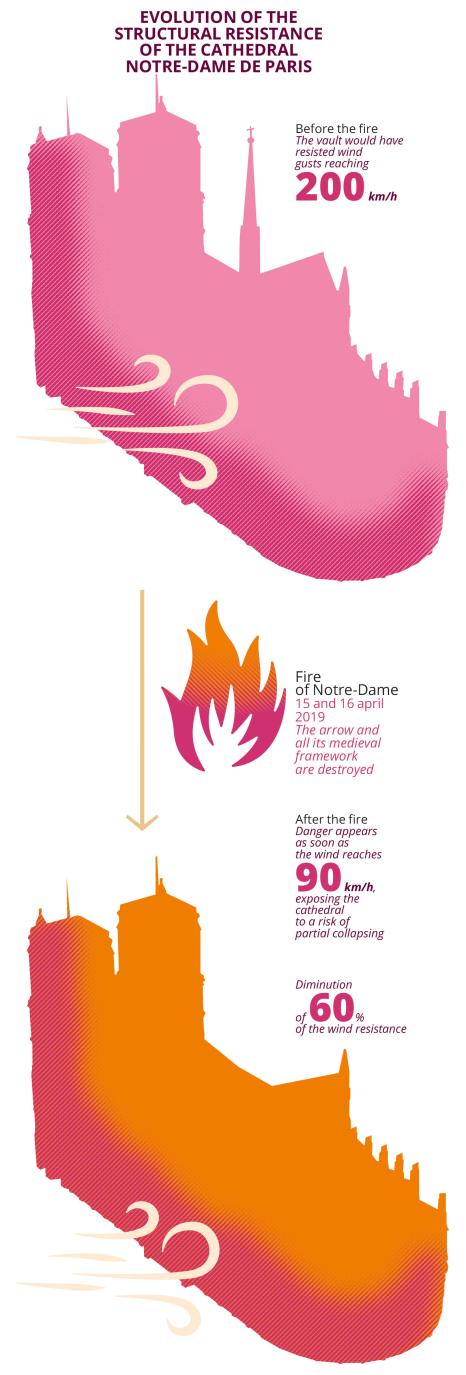
Deciphering history and heritage: Perspectives
This article was originally published in L'Édition n.22.
Heritage, the guardian of memories, always conceals a story to be deciphered. How can this object, at the crossroads of the past, present and future, be studied? This is an overview of the approaches taken by researchers at Université Paris-Saclay.
Heritage, a term often associated with historical legacy, is of considerable importance to society. Whether tangible or intangible, of cultural, historical, aesthetic or social value, heritage encompasses monuments, objects, traditions and practices that bear witness to the past and help to create a collective identity. However, the study and preservation of heritage face complex challenges that require a multi-dimensional and sometimes new approach. What are these approaches? What role does the scientific community play in heritage preservation?
Ethical challenges of digital humanities in research
The creation of data sets, simulations and advanced analyses means that digital technology is at the heart of our historical research activities. Giovanni Pietro Vitali, lecturer at the Heritage and Cultural Dynamics Laboratory (DYPAC - Univ. Paris-Saclay, UVSQ), for example, uses a range of programming languages such as R, Python and JavaScript to analyse texts and various archives. Its Last Letters from the World Wars project focuses on the linguistic and thematic analysis of the last letters of people sentenced to death during the World Wars. Using digital tools, it examines corpora of letters collected in Italian archives, identifying significant elements in these correspondences.
Paolo Vannucci, professor at the Mathematics Laboratory of Versailles (LMV - Univ. Paris-Saclay, UVSQ, CNRS), focuses on the study of large monumental structures, in particular Gothic cathedrals such as Notre-Dame de Paris. It seeks to understand the impact of extreme actions on these monuments and studies the structural thinking of ancient builders. Using simulations and digital archaeology, it studies the impact of buttresses, wind resistance and climatic action on cathedrals.
Digital humanities, a discipline that uses digital technologies and computer science to study knowledge in humanities and social sciences, raises questions about the use of data and algorithms. For example, they can be influenced by the training data used to develop them. If this data is biased, the results produced by the algorithms will also be biased. Cultural or linguistic biases are also a cause for concern, for example when machine translation algorithms favour certain languages or regions, or perpetuate cultural stereotypes. Privacy is another major concern, as these technologies often involve the collection, storage and analysis of vast amounts of personal data, raising questions about the confidentiality and privacy of individuals.
However, Giovanni Pietro Vitali points out that the transparency and accountability mechanisms offered by open science mitigate the biases and errors produced when using proprietary applications that do not guarantee full supervision of the internal processes of computational calculations, and guarantee results that benefit society as a whole. The researcher always raises the question of how to integrate open science technologies according to FAIR principles, which aim to promote the open access, reusability and interoperability of scientific data. The acronym FAIR stands for Findable - Accessible - Interoperable - Reusable. "I only work with programming languages such as R, to guarantee the complete autonomy of my product," adds the researcher.
He is also very active on GitHub, a cloud-based collaborative development platform used to host, manage and share source code projects. He shares all his projects, submissions and even tutorials there. In his study A Theatre of Places: mapping 17th French Theatre, the researcher uses text mapping to study the places mentioned in 17th-century French theatre literature. This textmapping technique not only allows us to draw conclusions about literary influences and the strength of the genre over the course of the century, it is also easily reproducible and entirely open source, as all sources are transparent and accessible to all.
Heritage vocabularies: an interdisciplinary issue
Marie Cornu, specialist in cultural and heritage law at the Institute of Social Sciences in Politics (ISP - Univ. Paris-Saclay, ENS Paris-Saclay, CNRS, Univ. Paris-Nanterre), emphasises the importance of language and the normative dimension in relation to other disciplines in her legal research. She co-edited the Dictionnaire de droit comparé du patrimoine culturel (Dictionary of comparative law of cultural heritage) in 2012, which takes a comparative approach to the question of heritage vocabularies in ten European countries, and the Dictionnaire des biens communs (Dictionary of Common Property), published in 2017 and republished in 2021, a project that brought together several disciplines around the notions of the common and common property (economists, jurists, political scientists, sociologists, etc.). For several years, she has been working with researchers in heritage sciences to create an interdisciplinary Dictionary of Heritage. This project aims to go beyond a simple description of concepts and adopt a reflective approach to the notion of heritage.
Marie Cornu and her team have also studied the genesis of the texts that form the normative field of heritage. The Mémoloi project, for example, focuses on exploring and understanding the origins of laws, in conjunction with the French Ministry of Culture's History Committee. The researchers are also interested in how the law interacts with time and how it is applied in practice, "We are interested in the law in action, taking into account the way it is reappropriated by the players involved," explains Marie Cornu. This dimension, which is crucial to understanding legal systems, is also a key research orientation at ISP.
Digital advances transforming heritage research
Thanks to the use of simulations and advanced modelling techniques, the researchers are now able to examine ancient constructions from every angle, even though in some cases there is no written record of them. This approach challenges some of the assumptions made in the literature.
Paolo Vannucci and his team used the finite element method to assess the structural resistance of Notre-Dame Cathedral in Paris, determining the critical threshold at which the building becomes vulnerable to wind forces. The results were striking, as before the fire of 2019, the vault would have withstood wind gusts of up to 200 km/h. There is now danger as soon as the winds reach 90 km/h, exposing the cathedral to the risk of partial collapse. This 60% reduction in wind resistance highlights the urgent need to take measures to secure this architectural landmark.
Other approaches, such as the discrete element method, which considers each particle individually, or the finite volume method, which divides the structure into small three-dimensional volumes, are also used to simulate granular movements and measure wind action on ancient monuments. Lastly, the limit analysis method aims to determine the maximum loads a structure can withstand before it collapses.
These advances provide a better understanding of the forces that shape ancient monuments and contribute to their preservation. "Engineers have a variety of more or less interchangeable methods and tools at their disposal, with their own applications and levels of accuracy. The diversity of approaches gives engineers the tools to find the right solution for each challenge," explains Paolo Vannucci.
Giovanni Pietro Vitali considers that his role is not limited to writing, but extends to the development of all technological innovations likely to improve research. "Advances in digital humanities offer new opportunities for revolutionising traditional approaches to humanities and social sciences," he explains. These opportunities include the analysis of vast data sets, which scientists can now use to identify trends, patterns and relationships that were once difficult to discern.
The Prismatic Jane Eyre project, in which the researcher is very involved, is a prime example. This study examines the linguistic transformations and variations that emerge in translations of Charlotte Brontë's famous novel Jane Eyre. By listing no fewer than 618 translations in 68 different languages, interactive maps have been created to highlight the global proliferation of this masterpiece and capture how it is understood across diverse contexts. "This 19th-century English novel, which was ahead of its time in terms of its feminist scope, is of particular literary interest. Our aim is to analyse how this work was received in various countries and study the interactions it has generated within different cultures. The project looked at the most popular editions and found that the most interesting reactions came from the Arabic-speaking and Chinese worlds. We examined how this English novel was received in these two cultures, which were undergoing significant changes at the time. In particular, we analysed the evolution of book covers over time and space," explains the researcher.
The study of historic monuments often requires the involvement of research teams from different disciplines. And reconciling experts in history with other scientists specialising in mechanics, mathematics or other disciplines can be a challenge, as Paolo Vannucci points out, "For example, when dealing with fracture mechanics in the analysis of monuments and their ultimate state, we may find ourselves talking to a colleague who is an expert in fracture mechanics and is considering problems on a millimetre scale. However, the problems encountered in cathedrals have dimensions that are measured in metres, which makes them totally different. Furthermore, the researcher points out that historical heritage issues are frequently raised in France, but their development is still limited." The study of historical heritage faces considerable budgetary constraints, often resulting in a lack of funding for preservation, research and restoration activities. There may also be problems of coordination between the various entities and players involved in preserving and managing historical heritage.
Researchers at Université Paris-Saclay, such as Marie Cornu, have been actively involved in the development of an interdisciplinary heritage science community. It brings together specialists from a variety of fields, including history, art history, sociology, law and experimental science. One of the first concrete results of this collaboration was the Nomade seminar, which aimed to explore conceptualisation methods in the field of heritage, based on themes such as authenticity and notions of origin, trace, provenance and trajectory.
"It was an experience that consolidated the heritage science community around a common reflection," adds Marie Cornu. These issues have been explored in depth in a number of fields, including scientific and technical heritage, archaeology, architecture, musicology, museology, conservation and restoration. A summer school organised by Ludwig Maximilian University in Munich and ISP, in close collaboration with the Graduate School Humanities - Heritage Sciences (GS HSP), Palabre interdisciplinary programme and the Franco-German University, also took place in September 2023 at Bibracte, a Gallic city dating from the first century BC and now preserved as an archaeological site in the heart of Burgundy-Franche-Comté. Workshops, lectures and seminars on topics such as the origin, illicit trafficking and collection of archaeological objects were all part of this summer school.
Mirroring this international collaboration, the Franco-Latvian Osmose project, conducted between 2014 and 2018, aimed to explore the diversity of normative systems related to intangible cultural heritage and examine the links between different branches of law. Marie Cornu, co-director of the ISP project in partnership with the Latvian Academy of Culture, explains, "Heritage law is often the preserve of governments or regions, and is generally a matter of national sovereignty. But it is built and defined in different ways. It is therefore interesting to compare the legal recognition of heritage and the way in which this area of law is implemented. To do this, we have set up an international network of active researchers."
Prosopography, Constantine and Byzantium
Vincent Puech, a historian specialising in the Byzantine world and Roman Antiquity, and Director of the Institute of Cultural and International Studies (IECI - UVSQ), uses the prosopographical approach to study historical figures. This method involves compiling thematic files on specific individuals in order to understand the social, political and cultural dynamics of the period. His research is in line with social and political history, focusing on family networks, geographical origins and religious issues. His first book, Constantin. Le premier empereur chrétien (2011) (Constantine, the First Christian Emperor), illustrates this thematic approach and his interest in the Byzantine world and Late Roman Antiquity (4th-6th centuries). In particular, he discovered that the ancient statues imported by the Roman emperor to decorate Constantinople, the capital of his empire built on the site of Byzantium, followed a precise logic. They include objects paying homage to the ancient cults of Byzantium and its inhabitants, despite Constantine's conversion to Christianity. This discovery led him to delve deeper into the question of ancient heritage in the Byzantine world.
Vincent Puech's approach to social history also opens up a methodological path to other disciplines. The historian explains that this approach is a form of history closely linked to sociology, focusing on the study of social groups and giving particular importance to their quantitative dimension. "Although carrying out a quantitative study of these periods is complex, prosopography can nevertheless be used to group individuals into series. If we then see that phenomena are repeated, we can learn from them. Furthermore, there is a qualitative aspect that addresses another branch of sociology, one that focuses more on the individual and aims to understand individual behaviour in greater depth, without considering individuals in a deterministic way," he adds.
Monuments, artefacts and civilizations dating back hundreds or even thousands of years are fascinating subjects of study which today require new resources and increased collaboration to overcome the compartmentalisation of research.
References
- V. Puech. « Les statues des bains de Zeuxippe à Constantinople : collection et patrimoine dans l’Antiquité tardive ». Anabases. 2016.
- P. Vannucci et al. “A study on the structural functioning of the ancient charpente of Notre-Dame, with a historical perspective”. Journal of cultural heritage. 2021. https://github.com/digitalkoine
- Marie Cornu et al. - Carnet Hypotheses « Droit, patrimoine et culture » : https://dpc.hypotheses.org/


